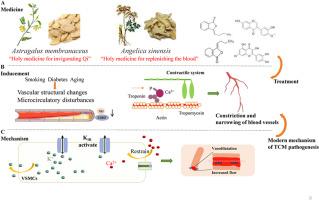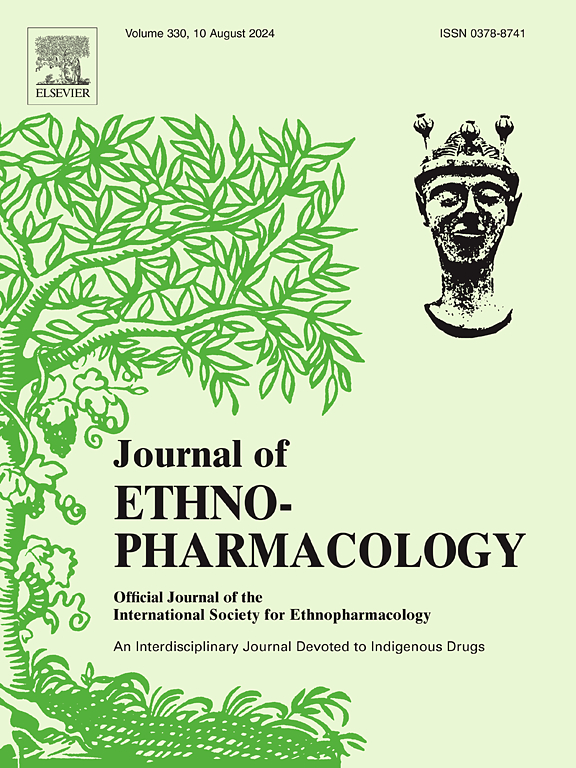Danggui Buxue Decoction and its components dilate coronary artery through activating the inward rectification K+ channels pathway
IF 4.8
2区 医学
Q1 CHEMISTRY, MEDICINAL
引用次数: 0
Abstract
Ethnopharmacological relevance
Danggui Buxue Decoction (DBD), a classic representative prescription of invigorating Qi and producing blood, is used to treat coronary heart disease angina pectoris and vascular injury diseases. Abnormal coronary artery is an important cause of cardiovascular disease. However, the mechanism of DBD dilates coronary arteries is still unclear.
Aim of the study
This study aimed to elucidate the impacts and distinctions among DBD, Astragalus, Angelica sinensis, and identified active components on pre-constricted coronary arteries, as well as to delve deeper into their respective mechanisms.
Materials and methods
After the preconstriction of a rat isolated coronary artery ring with either 30 mM KCl or 200 nM U46619, the vascular tension was observed following the addition of DBD, and other components. Subsequently, the impact of these active components on coronary blood flow (CBF) was confirmed through in vivo testing. Further investigation into the underlying mechanism was carried out using a combination of blockers, molecular docking, surface plasmon resonance (SPR), cell heat transfer analysis (CETSA), and patch-clamp techniques.
Results
In vitro experiments showed that DBD and its components butylidenephthalide, ligustilide, calycosin, and quercetin could dilate coronary artery preconstricted with either 30 mM KCl or 200 nM U46619. In addition, the active ingredient was found to significantly increase CBF. Mechanistically, BaCl2 was found to reduce the relaxation effect of the drug by adding a blocker. Molecular docking, SPR and CETSA results showed that the active ingredients had a strong binding potential with inward rectification K+ channels (KIR) channel protein. Patch clamp studies demonstrate that quercetin can increase KIR current, and BaCl2 can significantly reduce its current.
Conclusions
The active components of DBD, butylidenephthalide, ligustilide, calycosin, and quercetin, activate KIR channels to relax coronary artery and increase CBF.

当归附子汤及其成分通过激活内向整流 K+ 通道途径扩张冠状动脉。
民族药理学意义:当归附子汤(Danggui Buxue Decoction,DBD)是活气生血的经典代表方剂,用于治疗冠心病心绞痛和血管损伤疾病。冠状动脉异常是导致心血管疾病的重要原因。然而,DBD 扩张冠状动脉的机制仍不清楚:本研究旨在阐明 DBD、黄芪、当归和已鉴定的活性成分对预收缩冠状动脉的影响和区别,并深入研究它们各自的机制:用 30 mM KCl 或 200 nM U46619 对大鼠离体冠状动脉环进行预收缩后,观察加入 DBD 和其他成分后的血管张力。随后,通过体内测试证实了这些活性成分对冠状动脉血流量(CBF)的影响。通过结合使用阻滞剂、分子对接、表面等离子体共振(SPR)、细胞热传导分析(CETSA)和贴片钳技术,对其基本机制进行了进一步研究:体外实验表明,DBD及其成分丁烯基苯酞、藁本内酯、钙黄苷和槲皮素能扩张30 mM KCl或200 nM U46619预收缩的冠状动脉。此外,还发现活性成分能显著增加 CBF。从机理上讲,BaCl2 通过添加阻滞剂降低了药物的松弛效应。分子对接、SPR 和 CETSA 结果表明,活性成分与内向整流 K+ 通道(KIR)通道蛋白有很强的结合潜力。膜片钳研究表明,槲皮素能增加 KIR 电流,而 BaCl2 能显著降低其电流:结论:DBD 的活性成分丁烯基苯酞、女贞苷、萼苷和槲皮素可激活 KIR 通道,从而舒张冠状动脉并增加 CBF。
本文章由计算机程序翻译,如有差异,请以英文原文为准。
求助全文
约1分钟内获得全文
求助全文
来源期刊

Journal of ethnopharmacology
医学-全科医学与补充医学
CiteScore
10.30
自引率
5.60%
发文量
967
审稿时长
77 days
期刊介绍:
The Journal of Ethnopharmacology is dedicated to the exchange of information and understandings about people''s use of plants, fungi, animals, microorganisms and minerals and their biological and pharmacological effects based on the principles established through international conventions. Early people confronted with illness and disease, discovered a wealth of useful therapeutic agents in the plant and animal kingdoms. The empirical knowledge of these medicinal substances and their toxic potential was passed on by oral tradition and sometimes recorded in herbals and other texts on materia medica. Many valuable drugs of today (e.g., atropine, ephedrine, tubocurarine, digoxin, reserpine) came into use through the study of indigenous remedies. Chemists continue to use plant-derived drugs (e.g., morphine, taxol, physostigmine, quinidine, emetine) as prototypes in their attempts to develop more effective and less toxic medicinals.
 求助内容:
求助内容: 应助结果提醒方式:
应助结果提醒方式:


